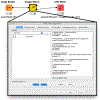Integration of the ImageJ Ecosystem in the KNIME Analytics Platform
- PMID: 32905440
- PMCID: PMC7469687
- DOI: 10.3389/fcomp.2020.00008
Integration of the ImageJ Ecosystem in the KNIME Analytics Platform
Abstract
Open-source software tools are often used for analysis of scientific image data due to their flexibility and transparency in dealing with rapidly evolving imaging technologies. The complex nature of image analysis problems frequently requires many tools to be used in conjunction, including image processing and analysis, data processing, machine learning and deep learning, statistical analysis of the results, visualization, correlation to heterogeneous but related data, and more. However, the development, and therefore application, of these computational tools is impeded by a lack of integration across platforms. Integration of tools goes beyond convenience, as it is impractical for one tool to anticipate and accommodate the current and future needs of every user. This problem is emphasized in the field of bioimage analysis, where various rapidly emerging methods are quickly being adopted by researchers. ImageJ is a popular open-source image analysis platform, with contributions from a global community resulting in hundreds of specialized routines for a wide array of scientific tasks. ImageJ's strength lies in its accessibility and extensibility, allowing researchers to easily improve the software to solve their image analysis tasks. However, ImageJ is not designed for development of complex end-to-end image analysis workflows. Scientists are often forced to create highly specialized and hard-to-reproduce scripts to orchestrate individual software fragments and cover the entire life-cycle of an analysis of an image dataset. KNIME Analytics Platform, a user-friendly data integration, analysis, and exploration workflow system, was designed to handle huge amounts of heterogeneous data in a platform-agnostic, computing environment and has been successful in meeting complex end-to-end demands in several communities, such as cheminformatics and mass spectrometry. Similar needs within the bioimage analysis community led to the creation of the KNIME Image Processing extension which integrates ImageJ into KNIME Analytics Platform, enabling researchers to develop reproducible and scalable workflows, integrating a diverse range of analysis tools. Here we present how users and developers alike can leverage the ImageJ ecosystem via the KNIME Image Processing extension to provide robust and extensible image analysis within KNIME workflows. We illustrate the benefits of this integration with examples, as well as representative scientific use cases.
Keywords: Bioimaging; Fiji; ImageJ; KNIME; computational workflows; image analysis; interoperability; open-source.
Conflict of interest statement
5Conflict of Interest CD, SH and MRB have a financial interest in KNIME GmbH, the company developing and supporting KNIME Analytics Platform. All other authors declare that the research was conducted in the absence of any commercial or financial relationships that could be construed as a potential conflict of interest.
Figures








Similar articles
-
The ImageJ ecosystem: Open-source software for image visualization, processing, and analysis.Protein Sci. 2021 Jan;30(1):234-249. doi: 10.1002/pro.3993. Epub 2020 Nov 20. Protein Sci. 2021. PMID: 33166005 Free PMC article.
-
ImageJ2: ImageJ for the next generation of scientific image data.BMC Bioinformatics. 2017 Nov 29;18(1):529. doi: 10.1186/s12859-017-1934-z. BMC Bioinformatics. 2017. PMID: 29187165 Free PMC article.
-
KNIME for Open-Source Bioimage Analysis: A Tutorial.Adv Anat Embryol Cell Biol. 2016;219:179-97. doi: 10.1007/978-3-319-28549-8_7. Adv Anat Embryol Cell Biol. 2016. PMID: 27207367
-
KNIME for reproducible cross-domain analysis of life science data.J Biotechnol. 2017 Nov 10;261:149-156. doi: 10.1016/j.jbiotec.2017.07.028. Epub 2017 Jul 27. J Biotechnol. 2017. PMID: 28757290 Review.
-
The ImageJ ecosystem: An open platform for biomedical image analysis.Mol Reprod Dev. 2015 Jul-Aug;82(7-8):518-29. doi: 10.1002/mrd.22489. Epub 2015 Jul 7. Mol Reprod Dev. 2015. PMID: 26153368 Free PMC article. Review.
Cited by
-
A community-based approach to image analysis of cells, tissues and tumors.Comput Med Imaging Graph. 2022 Jan;95:102013. doi: 10.1016/j.compmedimag.2021.102013. Epub 2021 Nov 19. Comput Med Imaging Graph. 2022. PMID: 34864359 Free PMC article. Review.
-
SciJava Ops: an improved algorithms framework for Fiji and beyond.Front Bioinform. 2024 Sep 27;4:1435733. doi: 10.3389/fbinf.2024.1435733. eCollection 2024. Front Bioinform. 2024. PMID: 39399098 Free PMC article.
-
Monitoring nucleolar-nucleoplasmic protein shuttling in living cells by high-content microscopy and automated image analysis.Nucleic Acids Res. 2024 Aug 27;52(15):e72. doi: 10.1093/nar/gkae598. Nucleic Acids Res. 2024. PMID: 39036969 Free PMC article.
-
Developing open-source software for bioimage analysis: opportunities and challenges.F1000Res. 2021 Apr 19;10:302. doi: 10.12688/f1000research.52531.1. eCollection 2021. F1000Res. 2021. PMID: 34249339 Free PMC article.
-
Bioimage analysis workflows: community resources to navigate through a complex ecosystem.F1000Res. 2021 Apr 26;10:320. doi: 10.12688/f1000research.52569.1. eCollection 2021. F1000Res. 2021. PMID: 34136134 Free PMC article.
References
-
- Afgan Enis, Baker Dannon, Batut Bérénice, Marius van den Beek, Dave Bouvier, Martin Čech, John Chilton, et al. 2018. “The Galaxy Platform for Accessible, Reproducible and Collaborative Biomedical Analyses: 2018 Update.” Nucleic Acids Research 46 (W1): W537–44. 10.1093/nar/gky379. - DOI - PMC - PubMed
-
- Aiche Stephan, Sachsenberg Timo, Kenar Erhan, Walzer Mathias, Wiswedel Bernd, Kristl Theresa, Boyles Matthew, et al. 2015. “Workflows for Automated Downstream Data Analysis and Visualization in Large-Scale Computational Mass Spectrometry.” Proteomics 15 (8): 1443–47. 10.1002/pmic.201400391. - DOI - PMC - PubMed
-
- Arganda-Carreras Ignacio, Kaynig Verena, Rueden Curtis, Eliceiri Kevin W, Johannes Schindelin, Cardona Albert, and Seung H Sebastian. 2017. “Trainable Weka Segmentation: A Machine Learning Tool for Microscopy Pixel Classification.” Bioinformatics 33 (15): 2424–26. 10.1093/bioinformatics/btx180. - DOI - PubMed
-
- Egloff Arnold, Shanna A, Liping Du, Holli A Loomans Alina Starchenko, Su Pei-Fang, Ketova Tatiana, Knoll Paul B, et al. 2017. “Shed Urinary ALCAM Is an Independent Prognostic Biomarker of Three-Year Overall Survival after Cystectomy in Patients with Bladder Cancer.” Oncotarget 8 (1): 722–41. 10.18632/oncotarget.13546. - DOI - PMC - PubMed
Associated data
Grants and funding
LinkOut - more resources
Full Text Sources
